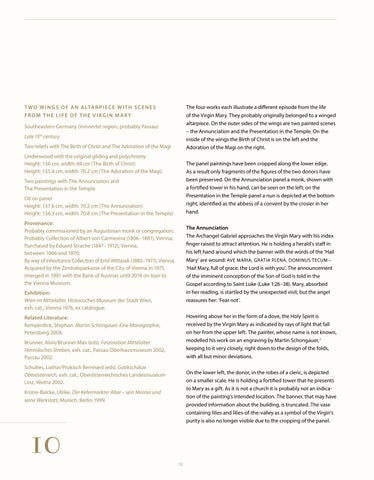T W O W I N G S O F A N A LTA R P I E C E W I T H S C E N E S FROM THE LIFE OF THE VIRGIN MARY
The four works each illustrate a different episode from the life of the Virgin Mary. They probably originally belonged to a winged altarpiece. On the outer sides of the wings are two painted scenes – the Annunciation and the Presentation in the Temple. On the inside of the wings the Birth of Christ is on the left and the Adoration of the Magi on the right.
Southeastern Germany (Innviertel region, probably Passau) Late 15th century Two reliefs with The Birth of Christ and The Adoration of the Magi Lindenwood with the original gilding and polychromy Height: 156 cm, width: 69 cm (The Birth of Christ) Height: 155.4 cm, width: 70.2 cm (The Adoration of the Magi)
The panel paintings have been cropped along the lower edge. As a result only fragments of the figures of the two donors have been preserved. On the Annunciation panel a monk, shown with a fortified tower in his hand, can be seen on the left; on the Presentation in the Temple panel a nun is depicted at the bottom right, identified as the abbess of a convent by the crosier in her hand.
Two paintings with The Annunciation and The Presentation in the Temple Oil on panel Height: 157.6 cm, width: 70.2 cm (The Annunciation) Height: 156.3 cm, width: 70.8 cm (The Presentation in the Temple) Provenance: Probably commissioned by an Augustinian monk or congregation; Probably Collection of Albert von Carmesina (1806 – 1881), Vienna; Purchased by Eduard Strache (1847 – 1912), Vienna, between 1866 and 1870; By way of inheritance Collection of Emil Wittasek (1885–1971), Vienna; Acquired by the Zentralsparkasse of the City of Vienna in 1975 (merged in 1991 with the Bank of Austria); until 2018 on loan to the Vienna Museum.
The Annunciation The Archangel Gabriel approaches the Virgin Mary with his index finger raised to attract attention. He is holding a herald’s staff in his left hand around which the banner with the words of the ‘Hail Mary’ are wound: AVE MARIA, GRATIA PLENA, DOMINUS TECUM – ‘Hail Mary, full of grace, the Lord is with you’. The announcement of the imminent conception of the Son of God is told in the Gospel according to Saint Luke (Luke 1:26 –38). Mary, absorbed in her reading, is startled by the unexpected visit, but the angel reassures her: ‘Fear not’.
Exhibition: Wien im Mittelalter, Historisches Museum der Stadt Wien, exh. cat., Vienna 1976, ex catalogue.
Hovering above her in the form of a dove, the Holy Spirit is received by the Virgin Mary as indicated by rays of light that fall on her from the upper left. The painter, whose name is not known, modelled his work on an engraving by Martin Schongauer, 1 keeping to it very closely, right down to the design of the folds, with all but minor deviations.
Related Literature: Kemperdick, Stephan. Martin Schongauer. Eine Monographie, Petersberg 2004. Brunner, Alois/Brunner Max (eds). Faszination Mittelalter. Himmlisches Streben, exh. cat., Passau Oberhausmuseum 2002, Passau 2002. Schultes, Lothar/Prokisch Bernhard (eds). Gotikschätze. Oberösterreich, exh. cat., Oberösterreichisches Landesmuseum Linz, Weitra 2002.
On the lower left, the donor, in the robes of a cleric, is depicted on a smaller scale. He is holding a fortified tower that he presents to Mary as a gift. As it is not a church it is probably not an indication of the painting’s intended location. The banner, that may have provided information about the building, is truncated. The vase containing lilies and lilies-of-the-valley as a symbol of the Virgin’s purity is also no longer visible due to the cropping of the panel.
Krone-Balcke, Ulrike. Der Kefermarkter Altar – sein Meister und seine Werkstatt, Munich, Berlin 1999.
10
72














